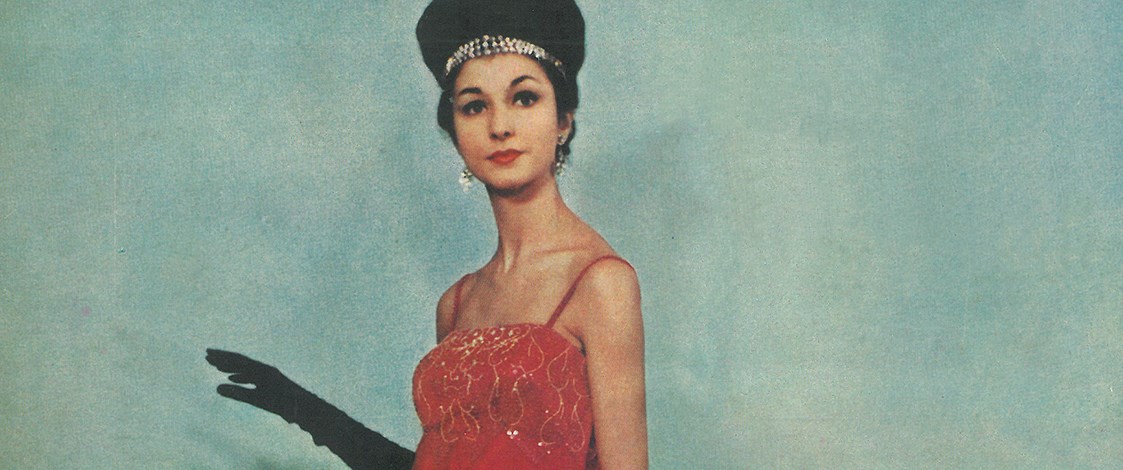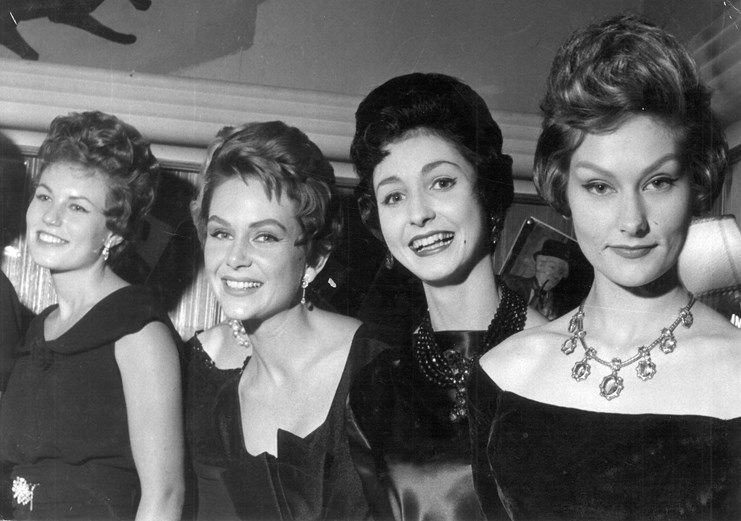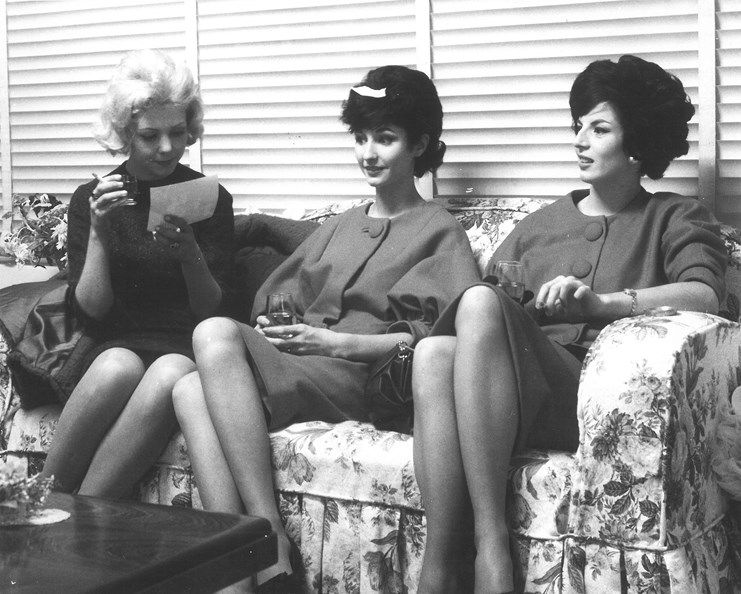Stories
Diane Cooper
1943-

At 14 Diane Cooper would catch the train from her home in Papakura into Auckland City then board a bus for the lengthy trip out to Titirangi for her weekly deportment lessons with model Else van den Muysenbergh. From Else she learned her first catwalk turns. Di would become known in fashion circles for her 'gamine' looks and vivacious personality.
"Because I started so young I was in awe of people like Ana Nielson, Shirley Gissing (Pater) and Carleen Spencer," she reflects. These were some of the big names in the evolving New Zealand fashion scene of the late 1950s. And of course Else van den Muysenbergh, who later set up modelling schools in Auckland city and Wellington. "She was just so elegant and exotic, having come from Europe."
Diane Cooper (left) and Else van den Muysenbergh photographed in Titirangi, circa 1959. Image © Auckland Star / Stuff.
Di went on to the Auckland Charm School run by Berin Spiro whom she describes as "an absolutely delightful man". Then to Peggie Wilson’s Academy of Elegance where she met Ann Lynch, at that time the Academy’s receptionist. The two would become top models and lifelong friends. For three seasons Di and Ann were models for fashion’s most prestigious annual event of the 1960s, the Gown of the Year parades.

Ann Lynch and Di Cooper. Image by PresStyle.
But it was as a sportswear model that Di first made her mark. "Sportswear was fun because you were allowed to smile and to just enjoy yourself. I was never a high fashion model – I couldn’t ever put on the haughty elegant look!"
Swimwear was a different story. "Swimsuits for me were a no no – skinny then was a nasty word. I was 5' 5 ½" tall (I always used to say 5' 6" to get a job) but very, very slim. I used to despair of my skinny arms and legs. I can remember going to our family GP, crying and saying, 'I’m taking the malt, the Lanes Emulsion, all the things one has to take to put on weight and I simply can’t.' And he told me I needed to spend a day in his surgery watching him cope with the health problems of obese people. 'Just rejoice in the way you are and many years later when you mature your body will thicken' was his advice. I’ve never forgotten that – now that it has thickened!" laughs a still slim Di.

One of Di's only swimwear modelling shoots, circa 1962. Image © Diane Goldsworthy.
Modelling was part-time and Di’s first job at 16 was as desk receptionist at Kays Beauty Salon managed by 'Miss Sophie' (Sophie Zac, who modelled for Babs Radon), the salon was patronised by a who’s who of fashion, media and show business.

A Kays Salon hair show. Lisa Babich, Annemarie Schazmann, Di Cooper and SophieZac. Image © Diane Goldsworthy.
"A lot of my work came from being Johnny on the spot," says Di. "People would come in to have their hair done and I’d be the first person they’d see. Then I’d be asked if I could come up and do a photo shoot in my lunch hour. It was nothing to do a parade at Milne & Choyce, John Court’s or Smith & Caughey’s and then get the trolley bus up to K Road for parades in George Court’s, Rendell’s or Flackson’s."
In those days salons like Kays would launch their new named seasonal cuts and styles twice a year involving designers such as Barbara Herrick. 'On-the-spot' Di also modelled for these hair shows. Getting time off to travel as a Gown of the Year model involved a complex but amicable 'resign and re-appointment' arrangement with the Cohens, owners of Kays Salon.
Tam Cochrane who ran the Gown of the Year 'Fashion on Wheels' show, kept a close eye on her youthful charges. "Those were the days when you actually just did as you were told," Di remembers. "Tam dictated the style. When we arrived at different destinations we’d go to the local salon. Sometimes we’d hate our hairstyle but we wouldn’t dream of complaining or trying to change it in any way. When we came back from Gown of the Year we’d say 'never again' but the next year there we’d be, lining up again because you only remember the good things."

Glenys Scott, Di Cooper and Ann Lynch take a break during the Gown of the Year show. Image © Diane Goldsworthy.
Showroom modelling for fashion buyers was another area of work. Once again Di was in demand for youth-focused designers such as American teen label Jonathan Logan, manufactured under licence in New Zealand by Nancy and Arthur Delaney of Puritan. Bill and Tony Lewis of Classic Fashions imported Sportscraft and "a lot of fabulous labels" that suited Di’s modelling style. Another American label, Teena Paige, came straight out of the pages of Di’s favourite Seventeen magazine, and was imported by Rose Coats. She remembers full skirts dipped in to the waist, Peter Pan collars, boat-shaped necklines, accessorised with short gloves and either kitten heels or ballerina shoes.
She was also an excellent hat model. Hats were an important part of everyday life and each season department stores produced show cards, head and shoulders photographs of models, that showcased their new millinery range. There were also live millinery parades.

Di Cooper was frequently employed to model millinery. Photo by Peter Callister, image © unknown.
"One of my first 'away' jobs was flying to Christchurch and Dunedin for one of the millinery companies, I think it was Plummer & Co. All you needed was the little black dress. They would fly all the millinery down to the stores for lunchtime parades and we’d walk around in our wee black dresses … just walk over to the mirror and put another hat on. It was fun."
During the 1960s fashions changed dramatically and so did catwalk styles. "Paddy Walker changed the modelling style dramatically with her coordination and choreography. Up until then we pretty much did what we felt like doing; we’d do Else’s turns and it was all very elegant and simple. Whereas Paddy had us dancing and doing stuff and that was never really my forte."
But Di remembers the sixties fondly. "We had to be so versatile; one minute you’re on a catwalk, the next you’re being photographed in hats. You did everything. And of course in our era there was glamour, with stars like Elizabeth Taylor and Audrey Hepburn (to whom Di was sometimes compared). Occasions were occasions. We would literally spend hours preparing. In fact when my daughter was born in 1967 I really resented that she was taking up so much time! I was so used to having all that time to put on the makeup to put on the hairpieces. That’s what we grew up with. You wouldn’t dream of going out with chipped nail enamel. And shoes dyed to match your handbag!"
There was remarkably little bitchiness, dieting, or tantrums among the women. "We were so lucky that models then were literally representing women of all shapes and sizes, whereas today they are like role models of how you should look. We were really able to just be ourselves. What makes a good model today is very different to what made a good model then. Models today will protest if something doesn’t suit them. Back then we were told what to do and we just got on with it. I think that’s why we all got on so well because there wasn’t that competitive streak where you are all trying to be the same. It was very comfortable."
Di married for the first time in 1964 and as Di Leaming ran her own deportment schools in Papakura, Pakuranga and Takapuna, while continuing to model. Papakura was still home and she was well known as a 'local girl made good'. She began compering and coordinating fashion parades, many of them for large charity occasions and events such as the Easter Show and for beauty pageants. Compering was something she continued to do for many years.
In the early 1980s Di became part-owner of Gallery Hair Fashions, a large salon in the Manukau shopping centre. Her business partner Murray Dunn had three daughters, the eldest of whom, beautiful red-headed Angela, was destined to become a top international model. Di organised hair and fashion shows at the Manukau Centre and it was for one of these shows that Angela brought her 14-year-old dance class friend to help out. That friend was the future Miss New Zealand and Miss Universe 1983, Lorraine Downes, who had her first modelling experiences under Di’s guidance.
Later in the 1980s, Meegan Pollock, the first woman board member of the Auckland Racing Club and owner of the Centrepoint fabric store in Newmarket, invited Di to help her with the judging, prize-giving and compering for Fashion in the Field. The Boxing Day race day fashion event at Ellerslie had been started many years before by the indomitable Peggie Wilson. Di and Meegan worked on Fashion in the Field together for a decade, increasing the level of sponsorship and quality of prizes to be won. "When Fashion in the Field first started you could win an Elna sewing machine," Di laughs. "When Meegan and I took over you could win a Mercedes!"
After the hair salon was sold in 1994, Di contemplated retirement. In 1988 she had married Bruce Goldsworthy, at that time director of the Auckland Manufacturer’s Association, and her first grandchild had been born in Sydney. But an approach from the Newmarket Business Association saw Di tackle a co-ordination job in one of Auckland’s biggest fashion districts. She has been there for 25 years and though retirement is imminent, she feels there will still be some way in which she can contribute.
"Not many people move away from the beauty and fashion industry into something completely different," she reflects. "Maybe it’s the glamour, maybe it’s just in our blood."
Text by Katherine Findlay. Banner image of Di Cooper on the cover of Woman's Viewpoint. Photo by Photocraft.
Published July 2019.